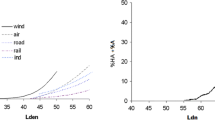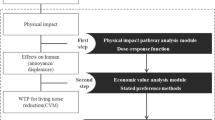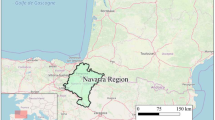Abstract
As the average noise level and number of noise sources have increased, governments have taken various measures to make soundscapes sustainable. Wise policy decisions require information about the monetary value of noise-control policies. This study elicited people’s willingness to pay (WTP) for noise policies, separating traffic noise from residential noise to compare the value of controlling different types of noise. The contingent valuation method was used for the empirical analysis, with data from South Korea. The results show that the monthly mean WTP of respondents was KRW 3392.3 for residential noise reduction and KRW 3507.1 for transport noise reduction; thus, the WTP for the latter is slightly higher than that for the former. Moreover, about 80% of people are unwilling to pay for a noise policy at all, and that high ratio of people with zero WTP must be taken into consideration in the process of policy formulation and implementation. Respondents’ experiential and psychological factors were found to be more important than their demographics in explaining their WTP for a noise policy. Potential policy implications based on the analysis results are provided.
Similar content being viewed by others
Notes
The main differences between CEs and the CVM and the merits of each are well summarized in Wardman and Bristow (2004).
“KRW” refers to the South Korean Won. According to the “Economic Statistics System” by the Bank of Korea (http://ecos.bok.or.kr), USD 1 = KRW 1144.09 in July 2016
As a pre-test, we conducted an online survey of 400 respondents aged 20 to 65 in the same eight metropolitan areas. Data from 13 respondents were excluded because they did not provide complete responses to all questions. In the pre-test, we asked for respondents’ WTP through open-ended questions. According to Kanninen (1993), the initial bid amount in DC formats should be between 12 and 88% of the pre-test results. In our consideration of the WTP value from the pre-test, we removed the top and bottom 15% of the data to remove outliers.
References
Aasvang GM, Engdahl B (2004) Subjective responses to aircraft noise in an outdoor recreational setting: a combined field and laboratory study. J Sound Vib 276:981–996
Adams M, Cox T, Moore G, Croxford B, Refaee M, Sharples S (2006) Sustainable soundscapes: noise policy and the urban experience. Urban Stud 43(13):2385–2398
Adersson H, Hammitt JK, Lindberg G, Sudström K (2013) Willingness to pay and sensitivity to time framing: a theoretical analysis and an application to car safety. Environ Resour Econ 56:437–456
Arrow K, Solow R, Portney PR, Leamer EE, Radner R, Schuman H (1993) Report of the NOAA Panel on Contingent Valuation
Bateman IJ, Carson RT, Day B, Hanemann M, Hanley N, Hett T, Jones-Lee M, Loomes G, Mourato S, Ozdemiroglu E, Pearce OBE DW, Sugden R, Swanson J (2002) Economic valuation with stated preference techniques: a manual. Edward Elgar, Cheltenham
Bjørner TB (2004) Combining socio-acoustic and contingent valuation surveys to value noise reduction. Transport Res D-Tr E 9:341–356
Bond CA, Giraud K, Larson D (2002) Temporal payment issues in contingent valuation analysis. presented in AAEA meeting in Long Beach, California
Bravo-Moncayo L, Naranjo JL, García IP, Mosquera R (2017) Neural based contingent valuation of road traffic noise. Transport Res D-Tr E 50:26–39
Bristow AL, Wardman M (2006) Valuation of aircraft noise by time of day: a comparison of two approaches. Transp Rev 26(4):417–433
Bristow AL, Wardman M, Chintakayala VPK (2015) International meta-analysis of stated preference studies of transportation noise nuisance. Transportation 42:71–100
Burgess M, Macpherson J (2016) Overview of Australian road traffic noise policy 2016. Acoust Aust 44:227–234
Cameron TA (1988) A new paradigm for valuing non-market goods using referendum data: maximum likelihood estimation by censored logistic regression. J Environ Econ Manag 15:355–379
Cameron TA, James MD (1987) Efficient estimation methods for “closed-ended” contingent valuation surveys. Rev Econ Stat 69(2):269–276
Carlsson F, Lampi E, Martinsson P (2004) The marginal values of noise disturbance from air traffic: does the time of the day matter? Transport Res D-Tr E 9:373–385
Carson RT, Flores NE, Meade NF (2001) Contingent valuation: controversies and evidence. Environ Resour Econ 19:173–210
Chalermpong S, Klaiklueng A (2012) Valuing aviation noise with the contingent valuation method: case of Suvarnabhumi airport, Bangkok, Thailand. Transportation Research Record: J Transport Res Board 2300:42–48
Chang JS, Kim DJ (2013) Hedonic estimates of rail noise in Seoul. Transport Res D-Tr E 19:1–4
Clark C, Martin R, van Kempen E, Alfred T, Head J, Davies HW, Haines MM, Barrio IL, Matheson M, Stansfeld SA (2006) Exposure-effect relations between aircraft and road traffic noise exposure at school and reading comprehension. Am J Epidemiol 163(1):27–37
Dekkers JEC, van der Straaten W (2008) Monetary valuation of aircraft noise: a hedonic analysis around Amsterdam airport. Ecol Econ 68(11):2850–2858
European Commission (2002) Directive of the European Parliament and of the Council of 25 June 2002 relating to the assessment and management of environmental noise. 2002/49/EC
Feitelson EI, Hurd RE, Mudge RR (1996) The impact of airport noise on willingness to pay for residences. Transport Res D-Tr E 1(1):1–14
Fosgerau M, Bjørner TB (2006) Joint models for noise annoyance and willingness to pay for road noise reduction. Transport Res B-Meth 40:164–178
Galilea P, Ortuzar JD (2005) Valuing noise level reductions in a residential location context. Transport Res D-Tr E 10:305–322
Garg N, Maji S (2016) A retrospective view of noise pollution control policy in India: status, proposed revisions and control measures. Curr Sci 111(1): 29–38
Hanemann WM (1984) Welfare evaluations in contingent valuation experiments with discrete responses. Am J Agric Econ 66(3):332–341
Herriges JA, Shogren JF (1996) Starting point bias in dichotomous choice valuation with follow-up questioning. J Environ Econ Manag 30:112–131
Huh SY, Lee J, Shin J (2015) The economic value of South Korea’s renewable energy policies (RPS, RFS, and RHO): a contingent valuation study. Renew Sust Energ Rev 50:64–72
Interagency Committees (2010) The 2nd comprehensive plan for reducing residential noise in order to reduce exposed population from noise and vibration. [In Korean] http://me.go.kr/home/file/readDownloadFile.do;jsessionid=qbdwekyAZpWd7ZkoVhkE3UXNKE485f1uZIM3cFJlFO0nlp4OMsxCuABuKuSjlFan.meweb1vhost_servlet_engine1?fileId=13166&fileSeq=1 (accessed April 9, 2018)
Istamto T, Houthuijs D, Lebret E (2014) Willingness to pay to avoid health risks from road-traffic-related air pollution and noise across five countries. Sci Total Environ 497–498:420–429
Joint Ministry of Korean Government (2015) The master plan for noise and vibration control 2016–2020. [In Korean]
Kanninen BJ (1993) Optimal experimental design for double-bounded dichotomous choice contingent valuation. Land Econ 69:138–146
Kim R, Noh H (2011) The supply plan for small-sized houses considering the preference of single and two-person household. Korea Housing Institute. [In Korean]
Kim KS, Park SJ, Kweon YJ (2007) Highway traffic noise effects on land price in an urban area. Transport Res D-Tr E 12:275–280
Ko JH, Chang SI, Kim M, Holt JB, Seong JC (2011) Transportation noise and exposed population of an urban area in the Republic of Korea. Environ Int 37:328–334
Kriström B (1997) Spike models in contingent valuation. Am J Agric Econ 79:1013–1023
Kuhfuss L, Hanley N, Whyte R (2016) Should historic sites protection be targeted at the most famous? Evidence from a contingent valuation in Scotland. J Cult Herit 20:682–685
Lee JH, Kang W, Yaang SR, Choy N, Lee CR (2009) Cohort study for the effect of chronic noise exposure on blood pressure among male workers in Busan, Korea. Am J Ind Med 52:509–517
Lee J, Gu J, Park H, Yun H, Kim S, Lee W, Han J, Cha JS (2014) Estimation of populations exposed to road traffic noise in districts of Seoul metropolitan area of Korea. Int J Env Res Pub He 11:2729–2740
Lewis SE, Popp JS, English LA, Odetola TO (2017) Willingness to pay for riparian zones in an Ozark watershed. J Water Resour Plan Manag 143(5):04017006
Li HN, Chau CK, Tse MS, Tang SK (2009) Valuing road noise for residents in Hong Kong. Transport Res D-Tr E 14:264–271
Loomis J, Lockwood M, DeLacy T (1993) Some empirical evidence on embedding effects in contingent valuation of forest protection. J Environ Econ Manag 24:45–55
Łowicki D, Piotrowska S (2015) Monetary valuation of road noise: residential property prices as an indicator of the acoustic climate quality. Ecol Indic 52:472–479
MacMillan D, Hanley N, Lienhoop N (2006) Contingent valuation: environmental polling or preference engine? Ecol Econ 60:299–307
Matos JCB, Flindell I, Le Masurier P, Pownall C (2013) A comparison of hedonic price and stated preference methods to derive monetary values for aircraft noise disturbance and annoyance. Transport Res D-Tr E 20:40–47
Mcconnell KE (1990) Models for referendum data: the structure of discrete choice models for contingent valuation. J Environ Econ Manag 18:19–34
McLeod DM, Bergland O (1999) Willingness-to-pay estimates using the double-bounded dichotomous-choice contingent valuation format: a test for validity and precision in a Bayesian framework. Land Econ 75(1):115–125
Merchan CI, Diaz-Balteiro L, Solino M (2014) Noise pollution in national parks: soundscape and economic valuation. Landsc Urban Plan 123:1–9
Miedema HME (2007) Annoyance caused by environmental noise: elements for evidence based noise policies. J Soc Issues 63(1):41–57
Miedema HME, Vos H (1998) Exposure-response relationships for transportation noise. J Acoust Soc Am 104:3432–3445
Ministry of Environment (2016) Management policy for noise and vibration in 2015: the assessment of implementation performance by region. Indoor Air, Noise and Asbestos Management Division in Ministry of Environment. [In Korean] http://www.me.go.kr/home/file/readDownloadFile.do;jsessionid=F1BDYw6yBVXv48qTb6lL4Y1OmUgffCrNZoej8CGgsDHay4plM3Ba5EuOpORXNkBP.meweb1vhost_servlet_engine1?fileId=133743&fileSeq=1 (accessed April 9, 2018)
Morrison MD, Blamey RK, Bennett JW (2000) Minimising payment vehicle bias in contingent valuation studies. Environ Resour Econ 16:407–422
Navrud S (2002) The state-of-the-art on economic valuation of noise. Final Report to European Commission DG Environment
Ouis D (2001) Annoyance from road traffic noise: a review. J Environ Psychol 21:101–120
Park SH, Lee PJ, Lee BK (2017) Levels and sources of neighbour noise in heavyweight residential buildings in Korea. Appl Acoust 120:148–157
Pommerehne WW (1988) Measuring the environmental benefits: a comparison of hedonic technique and contingent valuation. In: Bos D, Rose M, Seidl C (eds) Welfare and efficiency in public economics. Springer-Verlag, Berlin
Rollins KS, Shaykewich J (2003) Using willingness-to-pay to assess the economic value of weather forecasts for multiple commercial sectors. Meteorol Appl 10:31–38
Ryu H, Park IK, Chun BS, Chang SI (2017) Spatial statistical analysis of the effects of urban form indicators on road-traffic noise exposure of a city in South Korea. Appl Acoust 115:93–100
Saelensminde K (1999) Stated choice valuation of urban traffic air pollution and noise. Transport Res D-Tr E 4:13–27
Seidman MD, Standring RT (2010) Noise and quality of life. Int J Environ Res Pu 7:3730–3738
Soguel N (1994) Measuring benefits from traffic noise reduction using a contingent market. CSERGE Working Paper GEC 94–03, University of East Anglia, Norwich
Stewart J, Bronzaft AL, McManus F, Rodgers N, Weedon V (2011) Why noise matters: a worldwide perspectives on the problems, policies and solutions. Earthscan, New York
Sung JH, Lee J, Jeong KS, Lee S, Lee C, Jo MW, Sim CS (2017) Influence of transportation noise and noise sensitivity on annoyance: a cross-sectional study in South Korea. Int J Environ Res Pu 14:322
Thanos S, Wardman M, Bristow AL (2011) Valuing aircraft noise: stated choice experiments reflecting inter-temporal noise changes from airport relocation. Environ Resour Econ 50:559–583
Wang P, Wang Y, Zou C, Guo J (2017) A preliminary investigation of noise impact within metro stations in the urban city of Guangzhou. China Environ Sci Pollut Res 24:11371–11382
Wardman M, Bristow AL (2004) Traffic related noise and air quality valuations: evidence from stated preference residential choice models. Transport Res D-Tr E 9:1–27
Wardman M, Bristow A (2008) Valuations of aircraft noise: experiments in stated preference. Environ Resour Econ 39:459–480
Whitehead JC (2006) A practitioner’s primer on the contingent valuation method. In: Alberini A, Kahn JR (ed) Handbook on contingent valuation. Edward Elgar, Cheltenham, pp 66–91
Whitehead JC, Pattanayak SK, Van Houtven GL, Gelso BR (2008) Combining revealed and stated preference data to estimate the nonmarket value of ecological services: an assessment of the state of the science. J Econ Surv 22(5):872–908
Willig RD (1976) Consumer’s surplus without apology. Am Econ Rev 66(4):589–597
Wolde TT (2003) The EU noise policy and the related research needs. Acta Acust United Ac 89:735–742
Yoo SH (2007) Using one and one-half bounded dichotomous choice model to measure the economic benefits of urban noise reduction. Environ Resource Econ Rev 16(3):451–483 [In Korean]
Acknowledgments
This work was supported by the Korea Environment Institute (the research project entitled “An integrated approach to environmental valuation via impact pathway analysis”, Project Report 2016-10).
Author information
Authors and Affiliations
Corresponding author
Additional information
Responsible editor: Muhammad Shahbaz
Rights and permissions
About this article
Cite this article
Huh, SY., Shin, J. Economic valuation of noise pollution control policy: does the type of noise matter?. Environ Sci Pollut Res 25, 30647–30658 (2018). https://doi.org/10.1007/s11356-018-3061-4
Received:
Accepted:
Published:
Issue Date:
DOI: https://doi.org/10.1007/s11356-018-3061-4




